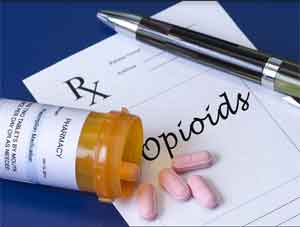- Home
- Editorial
- News
- Practice Guidelines
- Anesthesiology Guidelines
- Cancer Guidelines
- Cardiac Sciences Guidelines
- Critical Care Guidelines
- Dentistry Guidelines
- Dermatology Guidelines
- Diabetes and Endo Guidelines
- Diagnostics Guidelines
- ENT Guidelines
- Featured Practice Guidelines
- Gastroenterology Guidelines
- Geriatrics Guidelines
- Medicine Guidelines
- Nephrology Guidelines
- Neurosciences Guidelines
- Obs and Gynae Guidelines
- Ophthalmology Guidelines
- Orthopaedics Guidelines
- Paediatrics Guidelines
- Psychiatry Guidelines
- Pulmonology Guidelines
- Radiology Guidelines
- Surgery Guidelines
- Urology Guidelines
Prescribing opioids after surgery : JACS practice guidelines

The Opioids After Surgery Workgroup has released the guidelines on prescribing opioids after surgical procedures. The guidelines are published in the Journal of the American College of Surgeons (JACS).
The guidelines were developed concerning prescription of opioid medications following 20 commonly performed surgical procedures in adult patients who do not have surgical complications, do not have chronic pain and are opioid-naive. The postoperative pain management guidelines for opioid-naïve patients ranged from the minimum initial therapy to the maximum number of opioid tablets that should be prescribed at the time of discharge. The 20 procedures were chosen based on their minimal surgical variation and frequent performance. In this guideline, an opioid tablet is defined as an oxycodone 5 mg oral equivalent.
0 was recommended by the panel as the minimum number of opioid tablets prescribed for all procedures listed in the guidelines. Ibuprofen was recommended for all patients without contraindications.
Following 5 qualifying factors to be considered during the process of prescribing opioid medications, were established by the panel:
- The patient's potential medical contraindications, body weight, response to multimodal pain therapy, potential for addiction, and risk aversion should be considered before opioids are prescribed.
- Patients with terminal conditions should be considered special cases, since palliation may be an indication.
- Patients should be fully informed concerning the risks and benefits of opioids and be made aware that fatal addiction is a potential risk.
- Patients should be advised to maximize pain relief with non-opioids (acetaminophen, NSAIDs) before using opioid medications.
- The patient's wishes and history of medication effectiveness (i.e, in the past and during hospital stay) should be considered when prescribing any pain medication. Patients who overtly state a desire to avoid opioids should not be prescribed opioids. In addition, opioids should not be prescribed if the patient’s post surgical pain is adequately managed with non steroidal anti-inflammatory drugs (NSAIDs) and/or acetaminophen alone before discharge.
Key Recommendations:
- When postoperative opioids are not prescribed, patients should receive specific administration instructions for commonly available OTC nonopioid pain medications and receive instructions on how to seek help if the pain becomes debilitating using OTC analgesics alone.
- Patients should also receive discharge instructions (i.e, medications, doses, frequency) to optimize scheduled non-opioid medications, unless medically contraindicated.
- The maximum number of opioid tablets to prescribe postoperatively depends on the procedure but should not exceed 20. The minimum (0 in all cases) and maximum (if any) opioid tablets per selected procedure are listed below.
General Surgery
- Open umbilical hernia repair: 0-15 opioid tablets
- Open inguinal hernia repair, unilateral: 0-10 opioid tablets
- Laparoscopic inguinal hernia repair, unilateral: 0-15 opioid tablets
- Laparoscopic cholecystectomy: 0-10 opioid tablets
Breast Surgery
- Partial mastectomy with sentinel lymph node biopsy: 0-15 opioid tablets
- Partial mastectomy without sentinel lymph node biopsy: 0-10 opioid tablets
Thoracic Surgery
- Video-assisted thoracoscopic wedge resection: 0-20 opioid tablets
Cardiac Surgery
- Cardiac catheterization: 0 opioid tablets
- Coronary artery bypass grafting: 0-20 opioid tablets
Otolaryngology
- Cochlear implant: 0 opioid tablets
- Thyroidectomy, partial or total: 0-15 opioid tablets
Urologic Surgery
- Robotic retropubic prostatectomy: 0-10 opioid tablets
Gynecologic Surgery and Obstetric Delivery
- Uncomplicated vaginal delivery: 0 opioid tablets
- Uncomplicated cesarean delivery: 0-10 opioid tablets
- Minimally invasive hysterectomy: 0-10 opioid tablets
- Open hysterectomy: 0-20 opioid tablets
Orthopedic Surgery
- Open reduction and internal fixation (ORIF) of the ankle: 0-20 opioid tablets
- Arthroscopic rotator cuff repair: 0-20 opioid tablets
- Arthroscopic anterior cruciate ligament (ACL)/posterior cruciate ligament (PCL) repair: 0-20 opioid tablets
- Arthroscopic partial meniscectomy: 0-10 opioid tablets
"We describe 3 primary recommendations by the expert panel: provide patients with instructions to maximize nonopioid analgesics such as NSAIDs and acetaminophen; the minimum number of opioid tablets to prescribe after each procedure is 0, depending on procedure and patient characteristics; and the maximum number of opioid tablets to prescribe varies by procedure, but should not exceed 20 tablets for any of the selected common operations," write the authors.
"Despite the high overall rates of non-use of prescription opioids, an alarming 1 in 16 patients becomes a chronic opioid user after undergoing a surgical procedure. In response to these findings, surgeons and pain specialists have begun to consider best practices for the ideal amount of opioids to prescribe after common procedures," they concluded.
For further reference follow the link: https://doi.org/10.1016/j.jamcollsurg.2018.07.659

Disclaimer: This site is primarily intended for healthcare professionals. Any content/information on this website does not replace the advice of medical and/or health professionals and should not be construed as medical/diagnostic advice/endorsement or prescription. Use of this site is subject to our terms of use, privacy policy, advertisement policy. © 2020 Minerva Medical Treatment Pvt Ltd